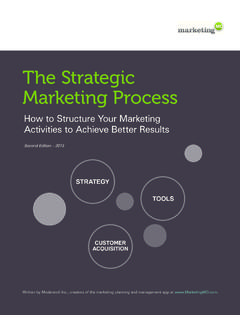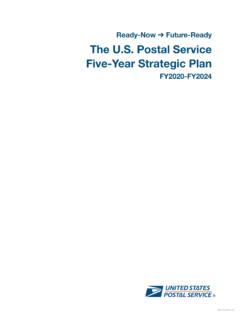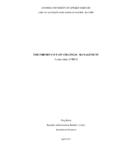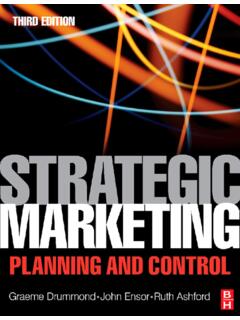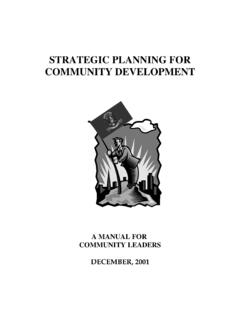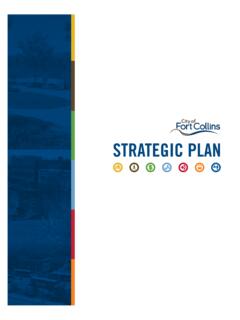Transcription of Strategic Planning - Marketing Department
1 University of PennsylvaniaScholarlyCommonsMarketing PapersWharton School1-1-1983 Strategic Planning and Forecasting FundamentalsJ. Scott ArmstrongUniversity of Pennsylvania, this and additional works at: of theMarketing CommonsPostprint version. Published inThe Strategic Management Handbook, edited by Kenneth Albert (New York: McGraw-Hill 1983), pages author asserts his right to include this material in paper is posted at more information, please CitationArmstrong, J. S. (1983). Strategic Planning and Forecasting Fundamentals.
2 Retrieved Planning and Forecasting FundamentalsAbstractIndividuals and organizations have operated for hundreds of years by Planning and forecasting in an intuitivemanner. It was not until the 1950s that formal approaches became popular. Since then, such approaches havebeen used by business, government, and nonprofit organizations. Advocates of formal approaches (forexample, Steiner, 1979) claim that an organization can improve its effectiveness if it can forecast itsenvironment, anticipate problems, and develop plans to respond to those problems.
3 However, informalplanning and forecasting are expensive activities; this raises questions about their superiority over informalplanning and forecasting. Furthermore, critics of the formal approach claim that it introduces rigidity andhampers creativity. These critics include many observers with practical experience (for example, Wrapp,1967). This chapter presents a framework for formal Planning and forecasting which shows how they interactwith one another. Suggestions are presented on how to use formal Planning for Strategic decision making.
4 (Forsimplicity, references to Planning and forecasting in this chapter will mean formal Strategic Planning andforecasting.) Planning is not expected to be useful in all situations, so recommendations are made on whenplanning is most useful. Descriptions of forecasting methods are then provided. Finally, suggestions are madeon which forecasting methods to use when developing plans for a version. Published inThe Strategic Management Handbook, edited by Kenneth Albert (New York:McGraw-Hill 1983), pages author asserts his right to include this material in journal article is available at ScholarlyCommons: Planning And Forecasting Fundamentals J.
5 Scott Armstrong From Kenneth Albert (ed.), The Strategic Management Handbook. New York: McGraw Hill, 1983, pp. 2-1 to 2-32. Individuals and organizations have operated for hundreds of years by Planning and forecasting in an intuitive manner. It was not until the 1950s that formal approaches became popular. Since then, such approaches have been used by business, government, and nonprofit organizations. Advocates of formal approaches (for example, Steiner, 1979) claim that an organization can improve its effectiveness if it can forecast its environment, anticipate problems, and develop plans to respond to those problems.
6 However, informal Planning and forecasting are expensive activities; this raises questions about their superiority over informal Planning and forecasting. Furthermore, critics of the formal approach claim that it introduces rigidity and hampers creativity. These critics include many observers with practical experience (for example, Wrapp, 1967). This chapter presents a framework for formal Planning and forecasting which shows how they interact with one another. Suggestions are presented on how to use formal Planning for Strategic decision making.
7 (For simplicity, references to Planning and forecasting in this chapter will mean formal Strategic Planning and forecasting.) Planning is not expected to be useful in all situations, so recommendations are made on when Planning is most useful. Descriptions of forecasting methods are then provided. Finally, suggestions are made on which forecasting methods to use when developing plans for a company. Where possible, the advice on Planning and forecasting is supported by relevant research. In some areas much research exists.
8 (For a review of the psychological literature on forecasting and Planning , see Hogarth and Makridakis, 1981.) In many areas, however, little research has been done. Various aspects of formal Planning and forecasting are illustrated here by using the Strategic decision by Ford to introduce the Edsel automobile in 1957. In this situation, formal Planning and forecasting would have been expected to be useful. Judging from published accounts by a participant at Ford (Baker, 1957) and an observer (Brooks, 1969), Ford did not use formal Planning and forecasting for the Strategic decisions involved in the introduction of the Edsel.
9 (Of course, having decided intuitively to proceed, they did carry out operational Planning for the production of the car.) The introduction of the Edsel is regarded as one of the largest business errors of all time. Ford itself lost $350 million. Their dealers also lost a substantial amount. Is it possible that formal Planning and forecasting might have protected Ford from such a large Strategic error? ? With acknowledgments to Richard C. Hoffman IV, Spyros Makridakis, Deepak Mehta and Robert Fildes, who provided useful comments on various drafts of this chapter.
10 Support for this paper was provided by IMEDE in Lausanne, Switzerland. 2 Figure 2-1 provides a framework to conceptualize Strategic Planning within a company. A scanning of the environment yields relevant data for the Data Bank. This data bank (or information system) would contain such data as government regulations, demographic indicators, industry sales, the resources of the company and of its competitors, and information on available technologies for production. Ideally, these data would be assembled in a central location, such as in a filing cabinet, chart room, or computer.

